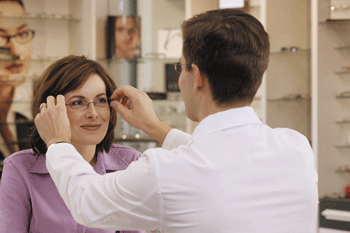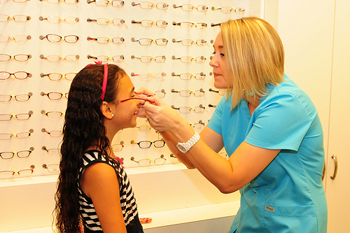Recently, I posted an article concerned with the purchasing of eyewear online.

Buying glasses online?
A friend raised the question of how to balance the cost-saving choice against the expense of eyewear. He cited an article about Luxottica and their monopoly on frames.
I have no financial interest in Luxottica, and I do not host an optical at my office. But as an eyecare provider, I do have concerns on where my patients choose to obtain their eyewear, and I refer to area opticians who provide quality and service with their work.
My concern is that the patient:
- …receive the prescription that I prescribed,
- …has selected a frame which is suited to their specific needs and use for the frame,
- …has the frame adjusted to fit them and stay in place for their intended purpose,
- …is personally comfortable with the feel of the eyewear, and
last (as well as least), - …is happy with the appearance of the frame.


 When an Rx is not filled correctly, the patient may not realize it, since they have 2 eyes bringing in information for a single image. If you have 2 copies of a piece of data, but one of the copies is somewhat marred, the natural thing to do is to cross-check the better-printed version and fill in the information gaps.
When an Rx is not filled correctly, the patient may not realize it, since they have 2 eyes bringing in information for a single image. If you have 2 copies of a piece of data, but one of the copies is somewhat marred, the natural thing to do is to cross-check the better-printed version and fill in the information gaps.
The same goes for image processing in the brain: When a lens Rx is filled incorrectly, the patient may make brain-based adaptations which change how they use their vision. They often will SUPPRESS muddled information. They may even experience changes in the measure/power of that eye… all without any awareness.
I have seen this firsthand: A patient returned to me with a mis-filled Rx, and this directly resulted in a change in the state of the mis-corrected eye by the next visit. This patient initially felt something was off, but he got used to it and ignored (“suppressed”) the problem. By the time the patient returned, he was completely unaware of the problem, in part because he had made internal changes, both in the eye and in the brain, to accommodate the change in his prescription.
Now consider that a person cuts corners to save money on their glasses. Some patients will go to an optical and select non-designer frames, whittle out all the bells-and-whistles from their lens choices. They may still come away with a good, well-made pair of glasses which serve the prescribed function.
However, when a patient opts to punch the prescription data and a frame selection into an internet-based eyewear site, no optician has checked for:
- appropriate fit,

- design of the frame for the eyewear demand,
- appropriate height/ location of the lens center,
- distance of the frame from the eyes, affecting lens power,
- feel of glasses on the bridge of the nose,
- considerations of lens power/ thickness/ lens material.
Nothing has been done to individualize the frame so that the patient will have the right feel and fit.
When such patients receive their frames, if they are not perfectly comfortable, they may go for help… to an optical.
- Is it “fair” that this is part of the professional service that the optician provides, built into their cost for eyewear?
- Is it “fair” that some of these discomforts could have been avoided with a guided selection process?
- If you were the optician, would you take the time to service a person/frame who has opted to cut corners and not pay for your expertise…?
- Who should service these frames?
The cost of eyewear is not the cost of eyewear.
It is the cost of the professional training and time to create a predictable, usable, functional tool.
It is the cost of keeping a store open with available hours to maintain service of that eyewear.
For this reason, I refer my patients to quality opticians. The skills they provide have impacts on my patients’ quality of life, day in and day out. If they do their job well, their patients are not likely to recognize their value until it is not available.


Leave a Reply